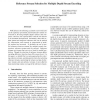Free Online Productivity Tools
i2Speak
i2Symbol
i2OCR
iTex2Img
iWeb2Print
iWeb2Shot
i2Type
iPdf2Split
iPdf2Merge
i2Bopomofo
i2Arabic
i2Style
i2Image
i2PDF
iLatex2Rtf
Sci2ools
3DPVT
2006
IEEE
2006
IEEE
Reference Stream Selection for Multiple Depth Stream Encoding
With advances in technology, a dynamic real world scene can be captured, represented, and streamed for realistic interaction in 3D using multiple digital cameras and computers. However, the captured data would be too massive to be streamed uncompressed. Fortunately, these data exhibit spatial and temporal coherence that can be utilized for compression, and research in compression of multiple streams has increased. To facilitate the use of spatial coherence between streams for multiple stream compression, reference streams must be selected. Reference streams are streams that serve as a basis for spatial prediction. Though the selection of reference streams affects encoding efficiency, there has been little research on it. In this paper, we identify the two main approaches for selecting reference streams, and demonstrate that when selecting reference streams, maximizing the volume overlap of reference streams and non-reference streams is more effective than maximizing volume coverage o...
Related Content
| Added | 10 Jun 2010 |
| Updated | 10 Jun 2010 |
| Type | Conference |
| Year | 2006 |
| Where | 3DPVT |
| Authors | Sang-Uok Kum, Ketan Mayer-Patel |
Comments (0)

